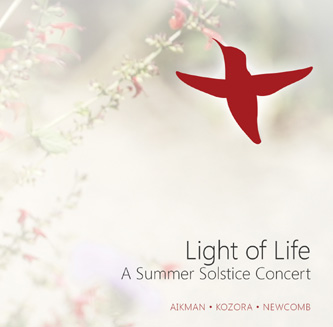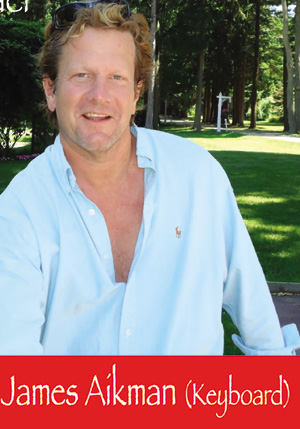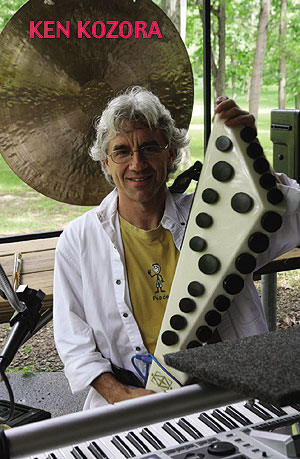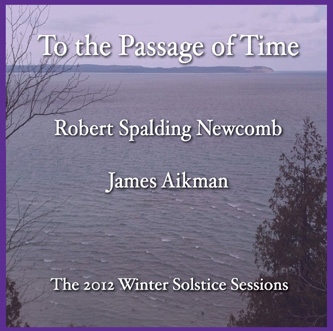 Back
in 2011, mwe3.com featured an interview with multi-instrumentalist
Robert Spalding Newcomb centered around his double CD set called
Anastasia Of The Gardens. Even though Newcomb is a first-rate
classical guitarist and sitar player, he also flexes his musical might
as a purveyor of all thing electronic. Electronic music in this case
means avant-garde—and
not in the spirit of New Age music. One look at Newcomb’s musical
influences offers a tell tale sign of his manifold approach to 20th
and 21st century music. Among Newcomb’s influences are Robert
Fripp, Harry Partch and Ravi Shankar. Catching up with Robert Spalding
Newcomb after a couple years, mwe3.com finally had some listening
time with his CD release of To The Passage Of Time -
an album Newcomb recorded with fellow composer James Aikman.
In the spirit of Robert Spalding Newcomb’s Anastasia double
CD, To The Passage Of Time is actually a superbly recorded
live album, filled with depth-defying electronic sounds very much
in the spirit of Wendy Carlos and even the late 1960s sound of Italian
avant-garde composer Luciano Berio. Recorded in Ann Arbor, Michigan
between May and December 2012, in rehearsal for the 12/21/2012 Winter
Solstice concert, To The Passage Of Time features liner notes
by James Aikman that goes into detail on the wide-ranging music within.
Following the CD release of To The Passage Of Time, in 2013
Robert Spalding Newcomb released Light Of Life: A Summer Solstice
Concert - recorded live on June 22nd 2013 and featuring Newcomb
on guitar and sitar performing live alongside James Aikman’s
keyboards and Ken Kozora on percussion, flutes and horn. More
varied than To The Passage Of Time, the Light Of Life
CD is accompanied by a DVD of the live performance along with other
scenic footage featuring contributions by Grace Chung and Mike
Halerz. With these impressive releases, Robert Spalding Newcomb
continues to take experimental guitar, sitar sounds and avant gard
electronic instrumental music to new heights. Keep an eye out for
Robert Spalding Newcomb’s next sitar album due for release on
CD in late 2015. www.PartialMusic.com
Back
in 2011, mwe3.com featured an interview with multi-instrumentalist
Robert Spalding Newcomb centered around his double CD set called
Anastasia Of The Gardens. Even though Newcomb is a first-rate
classical guitarist and sitar player, he also flexes his musical might
as a purveyor of all thing electronic. Electronic music in this case
means avant-garde—and
not in the spirit of New Age music. One look at Newcomb’s musical
influences offers a tell tale sign of his manifold approach to 20th
and 21st century music. Among Newcomb’s influences are Robert
Fripp, Harry Partch and Ravi Shankar. Catching up with Robert Spalding
Newcomb after a couple years, mwe3.com finally had some listening
time with his CD release of To The Passage Of Time -
an album Newcomb recorded with fellow composer James Aikman.
In the spirit of Robert Spalding Newcomb’s Anastasia double
CD, To The Passage Of Time is actually a superbly recorded
live album, filled with depth-defying electronic sounds very much
in the spirit of Wendy Carlos and even the late 1960s sound of Italian
avant-garde composer Luciano Berio. Recorded in Ann Arbor, Michigan
between May and December 2012, in rehearsal for the 12/21/2012 Winter
Solstice concert, To The Passage Of Time features liner notes
by James Aikman that goes into detail on the wide-ranging music within.
Following the CD release of To The Passage Of Time, in 2013
Robert Spalding Newcomb released Light Of Life: A Summer Solstice
Concert - recorded live on June 22nd 2013 and featuring Newcomb
on guitar and sitar performing live alongside James Aikman’s
keyboards and Ken Kozora on percussion, flutes and horn. More
varied than To The Passage Of Time, the Light Of Life
CD is accompanied by a DVD of the live performance along with other
scenic footage featuring contributions by Grace Chung and Mike
Halerz. With these impressive releases, Robert Spalding Newcomb
continues to take experimental guitar, sitar sounds and avant gard
electronic instrumental music to new heights. Keep an eye out for
Robert Spalding Newcomb’s next sitar album due for release on
CD in late 2015. www.PartialMusic.com
mwe3.com presents
an interview with
ROBERT SPALDING NEWCOMB
 mwe3:
Tell us how your Solstice Concerts started and how you met up with
James Aikman and Ken Kozora. Have you done only two Solstice concerts?
What’s the musical chemistry like between you, James and Ken
and are you still working together? Also you worked with James on
To The Passage Of Time as well, so you have an impressive history
with him. Can you compare the two Solstice Concert releases?
mwe3:
Tell us how your Solstice Concerts started and how you met up with
James Aikman and Ken Kozora. Have you done only two Solstice concerts?
What’s the musical chemistry like between you, James and Ken
and are you still working together? Also you worked with James on
To The Passage Of Time as well, so you have an impressive history
with him. Can you compare the two Solstice Concert releases?
Robert Spalding Newcomb: For most of my musical career I have
been a solo improvisational performer and solitary composer/programmer
of electronic and computer based music.
In 2011 I did a solo Winter Solstice Concert at Ann Arbor’s premier
independent showcase venue, Kerrytown
Concert House. After that, I had the idea of a Winter Solstice
concert with friends, doing duos and ensemble work, interleaved with
some solo pieces. The 2012 Winter Solstice Concert became this reality.
I have known James Aikman for almost 20 years and always admired his
work. He is currently Composer-in-Residence for the Indianapolis
Chamber Orchestra. James and I worked for a few months on
what we thought would be a single structured improvisational piece
for that show.
After the show, James and I brainstormed using takes from our rehearsals
as a possible CD, themed as a progression of ideas from midsummer
and culminating in the December concert performance. What we discovered
was quite intriguing, and as you can see from James’ liner notes,
the title “To The Passage Of Time” evolved very naturally
to describe the evolution of the composition. On a broader scale,
we share similar perspectives on life trajectories, and how we traverse
decades of searching for and discovering expressive techniques as
composers and thinkers.
I met Ken Kozora around the time of that concert, while I was working
with the southeast Michigan based dance company, PeopleDancing,
on a piece featuring me doing live guitar improvisation as the dance
choreography unfolded, also improvised to a high degree. Ken is the
Composer-in-Residence for PeopleDancing.
I invited Ken to join James and me to see what material we could develop.
The 2013 Summer Solstice Concert was the result of the next six months
of playing together. We had the great good fortune of enlisting another
colleague, Mike Halerz, in joining forces as videographer, and so
the ‘Light Of Life’ project was born. We continued to work
together and presented another Winter Solstice Concert that year,
and a 2014 Summer Solstice Concert in the same outdoor venue as we
used in 2013. Though James, Ken and I are not actively working together
now, Mike and I are collaborating on the upcoming sitar CD release
and concert.
mwe3: On the 2013 CD/DVD release of Light Of Life –
A Summer Solstice Concert you play several instruments and cover
a lot of ground. What guitars and sitars are you playing on the CD
/ DVD? Did you and James play the same instruments on To The Passage
Of Time as well? Have there been some new developments in the
gear world for you over the past few years?
 Robert
Spalding Newcomb: On both releases, I play a Godin Grand Concert
SA nylon string MIDI electric guitar. The ‘several instruments’
you hear are achieved through sound design within the Apple Logic
Pro architecture. On Light Of Life, I use that guitar and two
sitars – a single gourd model for “Light Of Life”,
and a double gourd (extra tomba) model for “Leaving Varanasi.”
James plays a Kurzweil K2500 keyboard on both releases.
Robert
Spalding Newcomb: On both releases, I play a Godin Grand Concert
SA nylon string MIDI electric guitar. The ‘several instruments’
you hear are achieved through sound design within the Apple Logic
Pro architecture. On Light Of Life, I use that guitar and two
sitars – a single gourd model for “Light Of Life”,
and a double gourd (extra tomba) model for “Leaving Varanasi.”
James plays a Kurzweil K2500 keyboard on both releases.
On “Light Of Life”, Ken utilizes a wide array of acoustic
and electronic percussion instruments, including the Zen Drum. He
is also a masterful flautist and trumpet player, and listening closely
one will hear a conch shell as well.
mwe3: How did you approach the music on both the CD/DVD of
Light Of Life and the To The Passage Of Time CD? Was
most of music improvised spontaneously or was some written and determined
before the concert? Is there more magic in the spontaneity of music?
Robert Spalding Newcomb: I am always improvisation based, and
my collaborators on these two projects are both master improvisers.
The “Passage” piece evolved from scratch, and the eventual
performance structure, both as a duo with James and as a trio with
Ken, resolved into a structured improvisation with some general sectional
transitions. These carry us through similar but still unique emotional
journeys each time we play the piece.
The sitar based pieces – “Leaving Varanasi” and “Light
Of Life” are original pieces that I have been playing for years
in solo settings. “Light Of Life” appears on my CD, Undiscovered
(2007). We adapted these to the trio instrumentation, and they simply
worked.
“Insects” and “Roots” are two pieces that grew
organically out of our rehearsals, each drawing from our respective
decades deep sonic toolkits.
mwe3: Your beautiful wife Grace is also in the Light Of
Life DVD. Tell us something about Grace, how you met her and tell
us about her artistic contributions to your music over the years.
Robert Spalding Newcomb: A little background - Grace and I
grew up next door to each other in Ann Arbor, parted ways at age 10-11
as our families relocated, then reconnected decades later. We have
been married for three years now.
After we shot the 2013 Summer Solstice Concert, in the beautiful University
of Michigan Matthaei Botanical Gardens, Mike and I set out
on a design path that would interweave video footage of the concert
with additional video material from the gardens and the many enchanting
woodland and prairie areas within the grounds. Including Grace as
‘woman of the woods and gardens’ seemed to be a natural
next step and it allowed us to add more of a characterization and
a storyboard of themes to distinguish the five musical pieces.
Grace has a background that spans theater, musical theater, dance,
martial arts, yoga, piano, ukulele and choral ensembles. She is now
avidly studying tabla and percussion. We have also collaborated in
the performance of a dance piece with PeopleDancing director Christina
Sears-Etter - sitar, tabla and tap dance.
 mwe3:
Who else was involved in the production of the Light Of Life CD
and DVD as well as To The Passage Of Time and who helped you
get such an excellent recorded sound on the CD and video quality on
the DVD? I saw the name Mike Halerz in the credits of the CD/DVD.
There’s so much great background footage in the DVD. Is that
mostly from India?
mwe3:
Who else was involved in the production of the Light Of Life CD
and DVD as well as To The Passage Of Time and who helped you
get such an excellent recorded sound on the CD and video quality on
the DVD? I saw the name Mike Halerz in the credits of the CD/DVD.
There’s so much great background footage in the DVD. Is that
mostly from India?
Robert Spalding Newcomb: I have known Mike Halerz for 20 years,
as our paths crossed at the University
of Michigan School of Music, Theatre & Dance, when I was
Director of IT and Mike was completing his degree studies. We recently
reconnected and soon found projects of mutual interest. Mike is a
tremendous audio/video engineer, multi-media designer and producer,
working freelance on commercial projects for small and large business
clients. I am blessed that he has chosen to make time for side ‘art’
projects such as mine.
For ‘Passage’, Mike mastered the audio, which involved working
only with stereo AIF files that were rough rehearsal mixes of both
James and me, spanning several months. This required a serious command
of post-production techniques.
The Light Of Life project upped the complexity level considerably,
but since Mike was involved from the outset, we were able to control
the many variables and create a ‘music video’ that we are
all proud of.
“Leaving Varanasi” was set against a photo collage I created
from my 2005 tour to India with Steve Rush, supported by the University
of Michigan and the US Embassy in Delhi.
Otherwise, all background footage was shot on subsequent beautiful
summer evenings at the botanical gardens.
mwe3: We spoke
back in 2011 and you were telling mwe3 about the difficulty for
an independent artist to break through these days. Has that gotten
a little more or less difficult nowadays? What do you make of all
the free music given away on youtube and through the streaming music
sites and how can we make the artists kings again?
Robert Spalding Newcomb: This is a tough topic. My double-edged
strategy has been to maintain a career outside the creative arts that
is steady and income producing. In my case, this turned out to be
IT. The breaking through aspect of a creative arts career can take
many twists and turns based on choices made about genre, networking,
mentors, location, instrument choice, etc. I have small pockets of
followers who may be most interested in my computer music, or the
sitar, or are pure experimental guitar devotees. I have had to reconcile
myself to being on the edge, since I have worked very hard to be there,
and accept that financial reward and fame may not be in the cards
for me this time through life.
 Social
media is of course transforming distribution, much as personal studios
and the minimization of hardware into software transformed media creation
and production. I believe that very soon, it will become affordable
to live stream our own concerts from small venues, even from a basement
or rooftop, and collect a fan base that is immediately loyal and supportive.
Fittingly, we will become as close to face-to-face with our audience
as we can be once again. Much of my music can be appreciated in a
non-live situation, but there really is nothing like being in the
same room as the performer, as the music is created.
Social
media is of course transforming distribution, much as personal studios
and the minimization of hardware into software transformed media creation
and production. I believe that very soon, it will become affordable
to live stream our own concerts from small venues, even from a basement
or rooftop, and collect a fan base that is immediately loyal and supportive.
Fittingly, we will become as close to face-to-face with our audience
as we can be once again. Much of my music can be appreciated in a
non-live situation, but there really is nothing like being in the
same room as the performer, as the music is created.
mwe3: Are you still involved in the computer world doing technical
work like designing system software etc? Where do you see the future
of the computer world and specifically where do you see the internet
going in the future? Are there any limits on technology?
Robert Spalding Newcomb: For the past two years I have been
Associate Director at the U-M
Digital Media Commons. For the last year I was also Interim
Studios Manager, managing state-of-the-art audio, video and electronic
music studios. In a higher education culture, at the crossroads of
engineering and the arts, I encounter many brilliant professionals
and students building the future of technology and its’ application
to the media arts. From what I can see, there are no limits to creativity
and imagination, and no boundaries of physics which cannot be explored
and perhaps pushed outward.
mwe3: You’ve lived all over the country and have visited a number
of other countries. Tell us about life in Ann Arbor and what makes
it a special place? Do you miss other places you have lived, like
New York City for instance? Is the size of our country (let alone
the world) an impediment to getting exposure and even doing concerts?
Robert Spalding Newcomb: Ann Arbor (A2) is my hometown, and
is of course home to the University of Michigan main campus. There
is a constant influx of new ideas, cultural perspectives, and most
importantly, fresh energy. The arts and music scene here is intense,
covering all styles and genres. The competition for audience is a
constant. It is a concert goers’ paradise. We have a high level
of musicianship in general, and the more or less affordable high standard
of living has given a lot of artists reason to settle here rather
than in an urban climate like NYC, LA, Chicago or Boston.
 I
miss every place I have lived, and I have moved quite often. I can
reflect on how the places we live shape us to some degree. For instance,
when I visit NYC, it really is so different now, as I am, that I would
not have any reason to live there. I was there when I was meant to
be, the late ‘70s to early ‘90s. We have to live somewhere,
and our life path will use that location/climate/society/culture matrix
as it will. My own lifestyle has not for many years allowed frequent
live performing, and even less so much opportunity for touring. The
logistics don’t work for me – that double edged strategy
I mentioned. That may change...
I
miss every place I have lived, and I have moved quite often. I can
reflect on how the places we live shape us to some degree. For instance,
when I visit NYC, it really is so different now, as I am, that I would
not have any reason to live there. I was there when I was meant to
be, the late ‘70s to early ‘90s. We have to live somewhere,
and our life path will use that location/climate/society/culture matrix
as it will. My own lifestyle has not for many years allowed frequent
live performing, and even less so much opportunity for touring. The
logistics don’t work for me – that double edged strategy
I mentioned. That may change...
mwe3: So I guess we’re all gearing up for your new CD
coming soon in 2015. Can you give us a little update on the name of
the new album and what else fans can expect to hear and see from you
in the coming months?
Robert Spalding Newcomb: The new CD is called Confluence
Of Elders – New Sitar Music for the 21st Century. It consists
of three original sitar compositions/improvisations recorded from
2007-2014. I have spent about 14 years playing sitar. I have been
lucky to have a few teachers from the Indian classical music tradition
guide my technique and understanding of the underlying theory of Hindustani
musical structures, but I have always kept myself on course to retain
my individual artistic vision for the instrument and its profoundly
intimate sound world.
This CD represents an offering of some of the treasures I have unearthed
along the way. I hopefully have expanded the scope of what a listener
will expect from the instrument, as well as what they might identify
as authentic work coming from a contemporary composer/improviser.
 For
this next
concert, my first solo one in four years, I am releasing the
new CD, and have decided to give it away as part of the ticket price
rather than simply offer it for sale at the event. To me, the point
of doing all this art, music, writing and software, is to communicate
with my fellow travelers on the planet. Handing a nice newly produced
CD to good friends and curious strangers coming out to experience
my performance seems the perfect gesture.
For
this next
concert, my first solo one in four years, I am releasing the
new CD, and have decided to give it away as part of the ticket price
rather than simply offer it for sale at the event. To me, the point
of doing all this art, music, writing and software, is to communicate
with my fellow travelers on the planet. Handing a nice newly produced
CD to good friends and curious strangers coming out to experience
my performance seems the perfect gesture.



